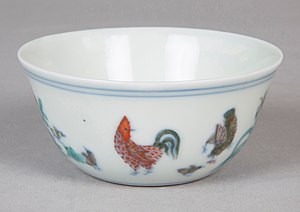| Chicken Cup | |
|---|---|
 Jingdezhen ware cup in the Metropolitan Museum of Art | |
| Material | Doucai porcelain with underglaze blue and overglaze coloured enamel |
| Size | Height: 4.1 cm (1.6 in) Diameter of rim: 8.3 cm (3.3 in) |
| Created | Chenghua period (1465-1487) |
| Period/culture | Ming Dynasty |
| Place | Jingdezhen, China |
A Chicken Cup is a bowl-shaped vessel made of Chinese porcelain painted in the doucai technique. Chicken cups were created during the Ming dynasty (1368 – 1644), during the Chenghua Emperor's reign (1465 – 1487) in China, and originally functioned as a vessel to drink wine from. Chenghua Chicken Cups were created in an imperial kiln in the Jingdezhen porcelain factory, in Southern China.[1] The Emperor Chenghua had the Chicken Cup created in the 15th century as an act of devotion for his empress mother who was recorded to have an appreciation for small objects and valued a simple design taste.[2]
Chicken cups are decorated with chickens, hens and cocks. There are a rooster and a hen which feed their young chick, as they grub for worms and stretch out their wings.[3] The chickens on the cup are interpreted as representing core dynastic Chinese values, such as continuing the family line and nurturing the young.[4] There are currently thirteen authentic Chenghua cups held by museums and three cups owned privately. Chicken Cups from the Chenghua period do not have specific dates of production or identified artists recorded.[5]

- ^ Krahl, Regina (2014-04-08). "The Meiyintang 'Chicken Cup'". Sotheby's. Retrieved 2019-05-16.
- ^ Murfin, Courtney (2014). "The Life of the Forbidden City". Magazine of the Royal Ontario Museum. 47 – via ProQuest.
- ^ "GLOSSARY: Chicken cup, Doucai decoration, Ming dynasty, Chenghua period (1465-1487)". gotheborg.com. Retrieved 2019-05-26.
- ^ "明成化 景德鎮窯鬥彩雞缸杯Chicken Cup". The MET. 2019. Retrieved 2019-05-15.
- ^ Cui, Yifang (2017). Speaking for the Chicken Cup: A case study in Chinese art collecting. Canberra: The Australian National University.